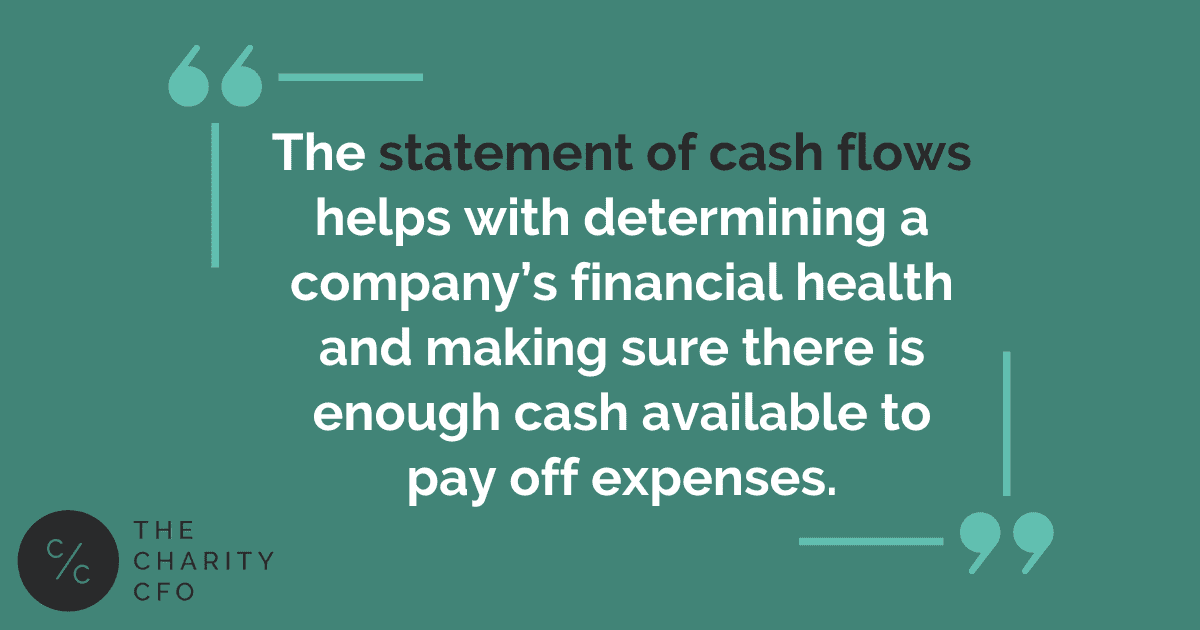Understanding the Nonprofit Statement of Cash Flows
Does your organization pay close attention to your nonprofit statement of cash flows?
When you think of financial statements, the balance sheet or income statement typically come to mind. While these are important components of a nonprofit’s success, the statement of cash flows is critical to understanding the timing and sources of cash moving in and out of your organization.

What is the nonprofit statement of cash flows?
Simply stated, the cash flow statement summarizes an organization’s cash management. It measures cash inflows and cash outflows, and it helps with determining a company’s financial health and making sure there is enough cash available to pay off expenses.
Cash flows are sorted into the below categories:
- Operating activities
- Investing activities
- Financing activities
Operating activities include anything that occurs during the normal course of business. These could include paying employee salaries and receiving donations or grants.
Investing activities include buying or selling long-term assets, such as purchasing new equipment or selling property.
Financing activities concern how your nonprofit is funded. Loans would fall under this category.
How to prepare the nonprofit statement of cash flows
Here are the main steps in preparing the statement of cash flows:
- Begin with net income or net loss
- Additions to cash
- Subtractions from cash
- Calculate cash flows from investing activities
- Calculate cash flows from financing activities
- Ending balance
Let’s dive in to see how this works.
-
Begin with net income or net loss
The first section of the statement of cash flows consists of operating activities. To prepare this section, you need to start with net income or net loss, which comes from your income statement (statement of activities). Next, you make adjustments to this number to undo accruals. Typically, nonprofits use accrual accounting, which recognizes revenue when it is earned instead of when the cash is received, and vice versa for expenses. While this method is very helpful to understanding some aspects of your organization’s financial position, it is not relevant to the statement of cash flows.
With the cash flow statement, you are not looking at when revenue was earned. You are looking at when the cash is coming in and coming out of the organization. The next 2 steps help with adjusting net income back into the cash basis.
-
Additions to cash
Next, you add back the values of the following:
- Depreciation expense
- Loss on the sale of an asset
- Decreases in current assets
- Increases in current liabilities
This may seem confusing at first, but the reason these values are added back to net income is because cash did not actually leave your nonprofit with the changes in these accounts. Remember that the income statement is calculated with the accrual method in mind, and the cash flow statement only looks at cash inflows and outflows. Let’s explain how this works.
Depreciation is when the cost of a physical asset is allocated over the course of its useful life. It recognizes how the value of the asset, such as a company car, decreases over time. Since depreciation expense is not an actual cash outflow, it needs to be added back to net income.
If your nonprofit sells an asset at a price that is lower than the asset’s book value, there was a loss on the sale of the asset. For instance, if you sold a lawn mower for $75 and its value was $100, there was a loss of $25, which is listed on the income statement. However, this is not a cash outflow, so the value of the loss will be added back to net income.
A decrease in a current asset, such as accounts receivable, means that customers paid their bills to you, and you have earned cash. Simply stated, a decrease in accounts receivable means there was an increase in cash, so you add this value back in.
Lastly, increases in current liabilities are added to cash. If there was an increase in accounts payable, there is more cash that your organization owes, but the cash has not yet left. Since this is not a cash outflow, this value is added back in.
-
Subtractions from cash
By now, you understand the logic behind the additions and subtractions from net income. When we subtract values from net income, it is the opposite of what we added in.
You will subtract:
- Gain on the sale of an asset
- Increase in current assets
- Decrease in current liabilities
This is because these changes do not represent cash inflows.
-
Calculate cash flows from investing activities
The investing activities and financing activities sections of the statement of cash flows are a lot easier to prepare than the operating activities section. You simply add or subtract cash inflows and outflows that result from these activities. For example, purchasing new equipment is a cash outflow, while selling property is a cash inflow.
-
Calculate cash flows from financing activities
Next, the cash flows for financing activities are calculated. Add or subtract cash inflows and outflows from these activities. For instance, receipt of cash from a loan would be added, while loan repayment would be subtracted.
-
Ending balance
The final step is to add together the total cash flows from operating activities, investing activities, and financing activities. The ending balance shows you the change in net cash for the period.
Interpreting the nonprofit statement of cash flows
Now that you understand all that goes into the nonprofit statement of cash flows, it’s time to explore how to use it! The nonprofit statement of cash flows is crucial to understanding your organization’s financial health and decision-making. Typically, you will want to have a positive cash flow because this means your organization has enough cash to both fund its operations and pay off short-term debts. However, negative cash flow may not be a bad thing if your organization spent cash to make major investments for the future.
Cash flow can be tricky for nonprofits because of the timing of donations. Nonprofit Quarterly discusses how cash inflow can be heavily concentrated during certain times of the year, such as during an annual fundraiser. Because of this, it can be difficult to manage cash over a period of time. Thankfully, using the nonprofit statement of cash flows can help you with sound decision-making.
Need help with the statement of cash flows?
The Charity CFO can help you with preparing and understanding monthly financial reports, including the statement of cash flows. Trusted by over 150 nonprofits and with a 99.5% client retention rate, we can be your go-to experts for outsourced accounting services and financial guidance.
To find out if The Charity CFO is right for your organization, request a free consultation today.







